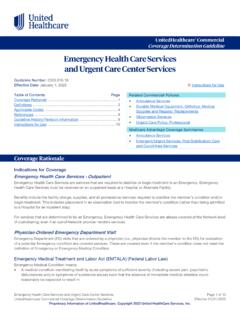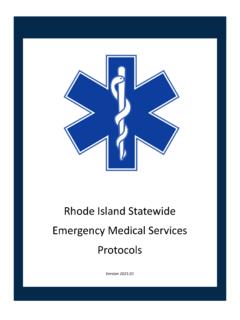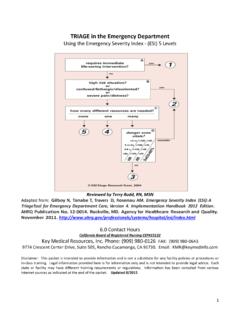Transcription of Certification and Compliance For The Emergency Medical ...
1 Certification and Compliance For The Emergency Medical treatment and labor Act (EMTALA) The Emergency Medical treatment and labor Act (EMTALA) requires hospitals with Emergency departments to provide a Medical screening examination to any individual who comes to the Emergency department and requests such an examination, and prohibits hospitals with Emergency departments from refusing to examine or treat individuals with an Emergency Medical condition. The term hospital includes critical access hospitals. The provisions of EMTALA apply to all individuals (not just Medicare beneficiaries) who attempt to gain access to a hospital for Emergency care. The regulations define hospital with an Emergency department to mean a hospital with a dedicated Emergency department. In turn, the regulation defines dedicated Emergency department as any department or facility of the hospital that either (1) is licensed by the state as an Emergency department; (2) held out to the public as providing treatment for Emergency Medical conditions; or (3) on one-third of the visits to the department in the preceding calendar year actually provided treatment for Emergency Medical conditions on an urgent basis.
2 Hospitals with dedicated Emergency departments are required to take the following measures: Adopt and enforce policies and procedures to comply with the requirements of 42 CFR ; Post signs in the dedicated ED specifying the rights of individuals with Emergency Medical conditions and women in labor who come to the dedicated ED for health care services, and indicate on the signs whether the hospital participates in the Medicaid program; Maintain Medical and other records related to individuals transferred to and from the hospital for a period of five years from the date of the transfer; Maintain a list of physicians who are on-call to provide further evaluation and or treatment necessary to stabilize an individual with an Emergency Medical condition; Maintain a central log of individual s who come to the dedicated ED seeking treatment and indicate whether these individuals: Refused treatment , Were denied treatment , Were treated, admitted, stabilized, and/or transferred or were discharged; Provide for an appropriate Medical screening examination; Provide necessary stabilizing treatment for Emergency Medical conditions and labor within the hospital s capability and capacity.
3 Provide an appropriate transfer of an unstabilized individual to another Medical facility if: The individual (or person acting on his or her behalf) after being informed of the risks and the hospital s obligations requests a transfer, A physician has signed the Certification that the benefits of the transfer of the patient to another facility outweigh the risks or A qualified Medical person (as determined by the hospital in its by-laws or rules and regulations) has signed the Certification after a physician, in consultation with that qualified Medical person, has made the determination that the benefits of the transfer outweigh the risks and the physician countersigns in a timely manner the Certification . (This last criterion applies if the responsible physician is not physically present in the Emergency department at the time the individual is transferred.)
4 Provide treatment to minimize the risks of transfer; Send all pertinent records to the receiving hospital; Obtain the consent of the receiving hospital to accept the transfer, Ensure that the transfer of an unstabilized individual is effected through qualified personnel and transportation equipment, including the use of medically appropriate life support measures; Medical screening examination and/or stabilizing treatment is not to be delayed in order to inquire about payment status; Accept appropriate transfer of individuals with an Emergency Medical condition if the hospital has specialized capabilities or facilities and has the capacity to treat those individuals; and Not penalize or take adverse action against a physician or a qualified Medical person because the physician or qualified Medical person refuses to authorize the transfer of an individual with an Emergency Medical condition that has not been stabilized or against any hospital employee who reports a violation of these requirements.
5 A hospital must formally determine who is qualified to perform the initial Medical screening examinations, , qualified Medical person. While it is permissible for a hospital to designate a non-physician practitioner as the qualified Medical person, the designated non-physician practitioners must be set forth in a document that is approved by the governing body of the hospital. Those health practitioners designated to perform Medical screening examinations are to be identified in the hospital by-laws or in the rules and regulations governing the Medical staff following governing body approval. It is not acceptable for the hospital to allow the Medical director of the Emergency department to make what may be informal personnel appointments that could frequently change. A hospital is required to report to CMS or the State survey agency promptly when it suspects it may have received an improperly transferred individual.
6 Notification should occur within 72 hours of the occurrence. Failure to report improper transfers may subject the receiving hospital to termination of its provider agreement.



















